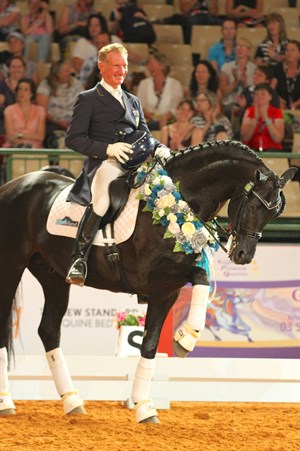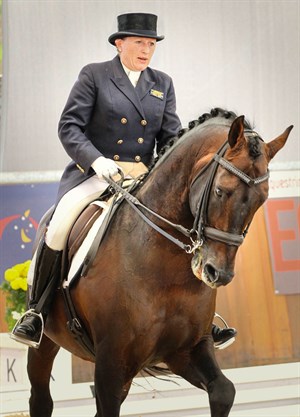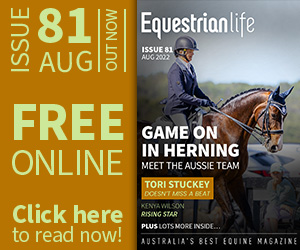
This article has appeared previously with Equestrian Life. To see what's in our latest digital issue, please click here.
Heath Ryan and his successful dressage stallion Regardez Moi.
© Roger Fitzhardinge
A good stallion must not only perform in the arena; he needs extra energy and stamina for the breeding season when called up for “double duty”.
By David Nash
If you look around the warm-up arena at a competition, you will see more and more green tags on saddle pads and bridles. In order for our stallions to promote themselves and their ability, they must perform to attract potential mare owners. Thus there are a lot more “double duty” stallions performing in Australia. This attracts a new set of nutritional challenges to ensure our stallions’ nutritional requirements are met for both performance and breeding.
The breeding stallion generally has an increased nutrient requirement of around 25 per cent more than the sedentary stallion during a non-breeding season. A performance stallion can have between 25 to 50 per cent increase in nutrient requirements depending upon workload and metabolism.
Feeding your performance stallion correctly during breeding season is extremely important. An imbalanced diet can result in injury and reduced performance for the competition side of his activity, and reduced fertility and conception rates for the breeding side.
Assessing your stallion’s condition score is especially important, both for performance and fertility. An animal that has a condition score that is too high will be carrying additional weight that can affect performance and increase the load on joints. Similarly, the stallion that is underweight and has a low condition score may not have sufficient energy reserves to perform - or continue to perform - at a high level. Also, this type of condition score may reduce fertility, semen motility and conformation. For stallions that tend to lose condition during breeding season, it may be wise to slowly increase their condition score over the winter months to avoid having to try and put weight on the horse whilst he’s breeding and performing. For a condition score chart, please go to www.barastochorse.com.au where you can also estimate your horse’s weight.
Kerry Mack riding her Grand Prix stallion, Mayfield Pzazz.
© Michelle Terlato Photography
As horses’ digestive systems evolved eating large amounts of roughage, it is essential to base any diet on a high roughage base. Essentially I would expect to see at least 1 per cent – preferably 1.5 per cent – of your stallion’s body weight in roughage per day. This would equate to around 7.5kg per day of hay/chaff and/or pasture. Having a good sound roughage base for your stallion’s diet will assist in maintaining a healthy gastro-intestinal tract and assist in reducing gastric complications such as colic.
Filling the gap from roughage to meet your stallion’s nutrient requirement depends on many factors, such as weight, condition score and workload. It is important if you are feeding a prepared feed to ensure that you feed the advised feeding rate, as these have been formulated to meet your horse’s requirements. If, for example, your stallion is receiving 1-2kg of additional feed per day, I would suggest a concentrated feed that has been formulated to meet your horse’s requirements at a lower inclusion rate. If you are feeding your stallion 3-5kg per day, I would suggest looking at feeds that are actually designed to be fed at this rate to ensure the full nutrient requirements are met.
With more dedicated research on fertility in stallions, several key nutrients have been focussed on that assist with fertility and recovery of stallions. The diet of a performance stallion not only needs to ensure that essential amino acids are present in sufficient quantities to assist in normal metabolism, but also to assist in recovering from strenuous performance and maintaining fertility functions.
Electrolytes are often forgotten, but a deficiency in electrolytes that control the contraction and release of muscles during performance - both in the arena and in the breeding barn - can lead to reduced performance and injury.
Antioxidants such as vitamin E and selenium, in combination with omega-3 essential fatty acids such as DHA and EPA, have dual roles in the body. They have long been known to protect the body from oxidative and inflammation stress as a result of metabolism and activity, but research has also shown that these types of antioxidants have improved sperm count, sperm conformation and longevity. This can result in fewer serves per conception, meaning your stallion does not have to work as hard while also reducing his risk of injury. Also, research has shown that diets with adequate amounts of these ingredients can also improve quality and persistence when chilling or freezing semen.
During breeding season, your stallion’s nutritional demands will increase significantly. Ensuring your stallion performs both in the competition arena and in the breeding barn is of the utmost importance when it comes to the success of your double duty stallion.
READ THE LATEST NEWS ARTICLES HERE
https://www.equestrianlife.com.au/articles/When-double-duty-calls


